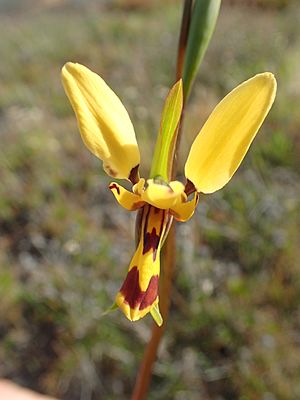Granite bee orchid facts for kids
Quick facts for kids Granite bee orchid |
|
|---|---|
 |
|
| Diuris picta growing near the western edge of Wave Rock | |
| Scientific classification | |
| Genus: |
Diuris
|
| Species: |
picta
|
The Diuris picta, also known as the granite bee orchid or granite donkey orchid, is a special type of orchid. It grows only in the south-western part of Western Australia. This orchid usually has three to five leaves near its base. Its flowers are creamy-white or yellow with brownish-purple marks. You can find it growing on rocky areas called granite outcrops, between the towns of Menzies and Lake King.
Contents
What Does the Granite Bee Orchid Look Like?
The granite bee orchid is a tuberous plant, which means it has a round, underground storage part. It's a perennial herb, so it lives for more than two years and has soft stems. It has three to five leaves at its base. Each leaf is about 80 to 150 mm (3 to 6 inches) long and 2 to 4 mm (0.08 to 0.16 inches) wide.
This orchid can have up to eight flowers on one stem. The flowers are creamy-white to yellow with brownish-purple patterns. Each flower is about 20 to 30 mm (0.8 to 1.2 inches) long and 12 to 15 mm (0.5 to 0.6 inches) wide. The flowering stem itself can be 200 to 350 mm (8 to 14 inches) tall.
The top part of the flower, called the dorsal sepal, curves upwards. It is about 15 to 20 mm (0.6 to 0.8 inches) long. The side sepals point downwards and are about 18 to 22 mm (0.7 to 0.9 inches) long. The petals stand up or bend backward. They are about 13 to 17 mm (0.5 to 0.7 inches) long.
The bottom part of the flower, called the labellum, is about 15 to 18 mm (0.6 to 0.7 inches) long. It has three main parts, or lobes. The middle lobe is shaped like an egg and is about 12 to 15 mm (0.5 to 0.6 inches) long and wide. The two side lobes are smaller. You can also see two raised lines, called callus ridges, near the base of the labellum. These are about 7 to 9 mm (0.3 to 0.4 inches) long. The granite bee orchid usually blooms in September and October.
How Did It Get Its Name?
The Diuris picta was first officially described in 1853. A botanist named James Drummond wrote about it in a science journal. The second part of its scientific name, picta, comes from a Latin word. It means "coloured" or "painted," which fits this orchid's pretty markings.
Where Does It Grow?
The granite bee orchid grows in specific areas of Western Australia. You can find it between the towns of Menzies and Lake King. It lives in different natural regions, including the Avon Wheatbelt, Coolgardie, Mallee, and Yalgoo areas. These regions are known for their unique plant life.
Is It Safe?
The good news is that the Western Australian Government's Department of Parks and Wildlife says the Diuris picta is "not threatened." This means it is not currently in danger of disappearing.

